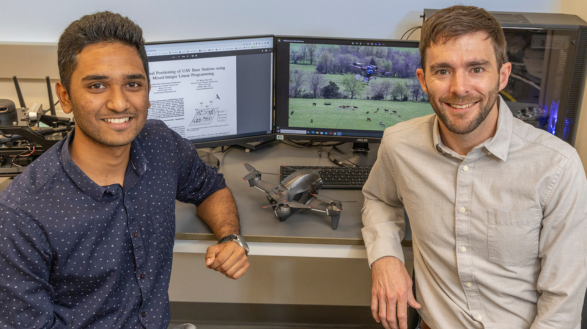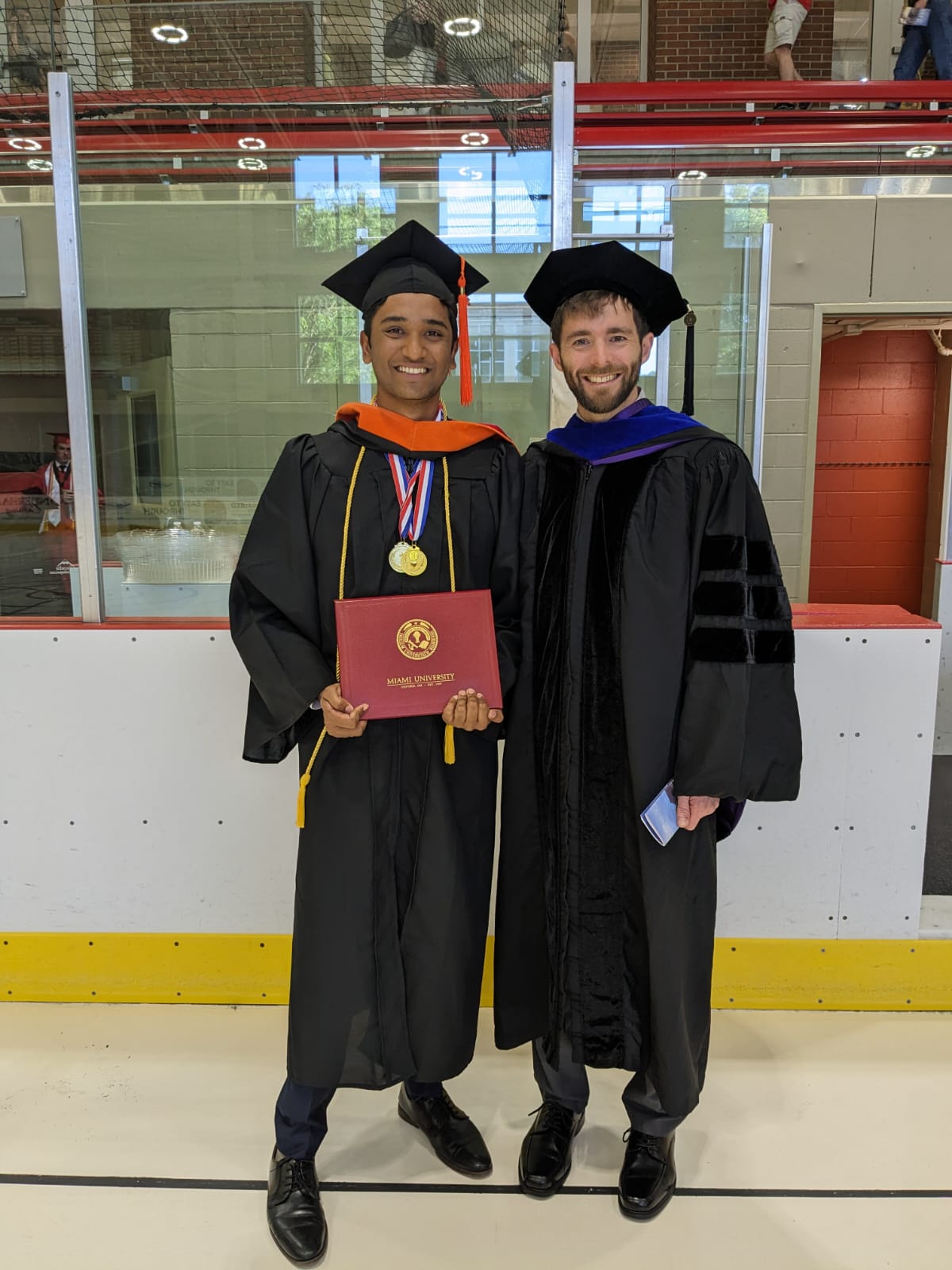College of Engineering and Computing research optimizes autonomous drone swarms with AI for potential disaster response applications
Gowtham Raj Veeraswamy Premkumar, M.S. ’24 and CEC assistant professor Bryan Van Scoy’s research optimally places cellular connectivity where it is most needed.

College of Engineering and Computing research optimizes autonomous drone swarms with AI for potential disaster response applications
On a typical day, finding yourself without cell reception is an inconvenience. But in a disaster scenario requiring on-the-ground rescue response, a lack of connectivity can mean life or death. Assistant Professor of Electrical and Computer Engineering Bryan Van Scoy and recent Master of Science graduate Gowtham Raj Veeraswamy Premkumar have collaborated on research that can be applied to disaster scenarios to reinstate cellular connectivity when base towers are down by using swarms of autonomous drones optimized with machine learning.
“What we are trying to do is provide a swarm of UAVs [Unmanned Aerial Vehicles, often referred to as drones] which would provide network connectivity without base stations,” said Gowtham Raj, who graduated from the College of Engineering and Computing in May 2024 with a Master of Science in Electrical and Computer Engineering. “They get connectivity directly from the satellite, and each drone can provide a network for 20 users.” Gowtham Raj explained that with this functionality, the drone swarm (a group of interconnected drones) could act as a remote base station which can move to where it is most needed. “My part in this research is to make these drones fly autonomously, without any human intervention,” he said.
UAVs, or drones, are currently used in a number of ways in society. They’re used for deliveries, for surveillance, and for fun. But in most applications, UAVs are operated through a remote control system, with a person physically controlling the operation of the drone. However, in Gowtham Raj and Van Scoy’s use case, manual operation of an entire swarm of drones is too complicated for one remote control. Because of this, artificial intelligence is incorporated into the operation of the interconnected drone swarms, so that they can optimally position themselves where they are most needed.
In a continuation of research first conducted by Ran Zhang, Ph.D., former assistant professor of Electrical and Computer Engineering at Miami University, Gowtham Raj and Van Scoy’s research incorporates neural networks and deep reinforcement learning to provide a central control action for all the drones. In the first iteration of this research with former assistant professor Zhang, each individual drone had “its own ‘brain’ to position itself where the ground users are,” said Gowtham Raj. However, he said, in this subsequent phase of the research, “a centralized algorithm positions these drones as a swarm.” In other words, one central control action controls all the drones and optimally positions itself where the users are, autonomously. This allows more drones to work together to provide more connectivity for an optimal number of ground users.

Gowtham Raj on graduation day, with his research advisor Van Scoy. “He motivated me until the end,” Gowtham Raj said of his advisor.
The deep reinforcement learning used by Gowtham Raj and Van Scoy in this project is an advanced machine learning technique currently at work in technologies like ChatGPT. Using this advanced machine learning, the research duo has focused on reducing the time complexity of drone swarm positioning. “The central algorithm had some time issues: it took more time to position where the ground users are,” Gowtham Raj said. To solve this, “we did mathematical optimization on how to position the drones where there are a maximum number of users.” Using industrial optimization solvers and mathematical modeling around the constraints of drone bandwidth and operational boundaries, Gowtham Raj and Van Scoy worked on how to ensure the drone swarm flew autonomously to areas where there were a large number of users in need of connection.
Gowtham Raj and Van Scoy’s research centered on a simulation environment with disaster response as just one possible application for their work. Their research focused on drone swarm operations in which the swarms autonomously traveled to “places where there are dense clusters of users, rather than going to a place where there are no users and when the resources are spent unnecessarily,” Gowtham Raj said.

Gowtham Raj (back row) poses with friends on an excursion in Cincinnati. He said his time as a Miami University graduate student has been “the best two years of my life.”
Originally from South India, Gowtham Raj’s time at Miami University has included more than just exceptional research opportunities. He said his time as a graduate student in Oxford has been “the best two years of my life, because I have a great friend circle” with other graduate and Ph.D. students from across the university. His relationship with Van Scoy has also been extremely positive. “(Van Scoy) supported me a lot,” Gowtham Raj said. “He motivated me until the end. He showed me the path, and I traveled towards that, and that's how this ended successfully.”
For his part, Van Scoy is just as appreciative of Gowtham Raj’s efforts and talents. “"Gowtham Raj has been exceptionally motivated to succeed,” said the Electrical and Computer Engineering faculty member, a department which celebrates its 20th anniversary this academic year. “This helped him persevere … to successfully complete his master's degree at Miami University."